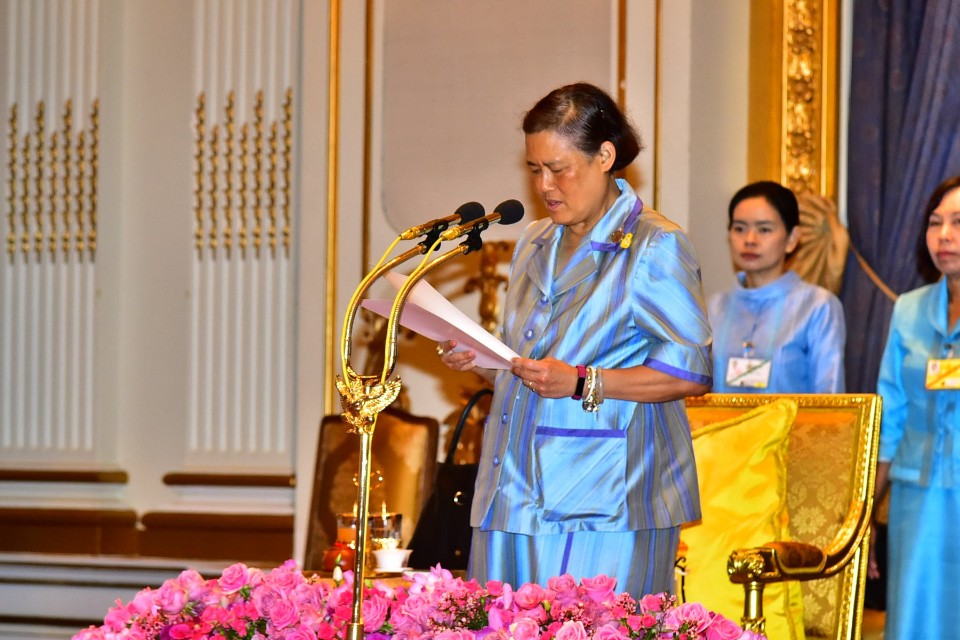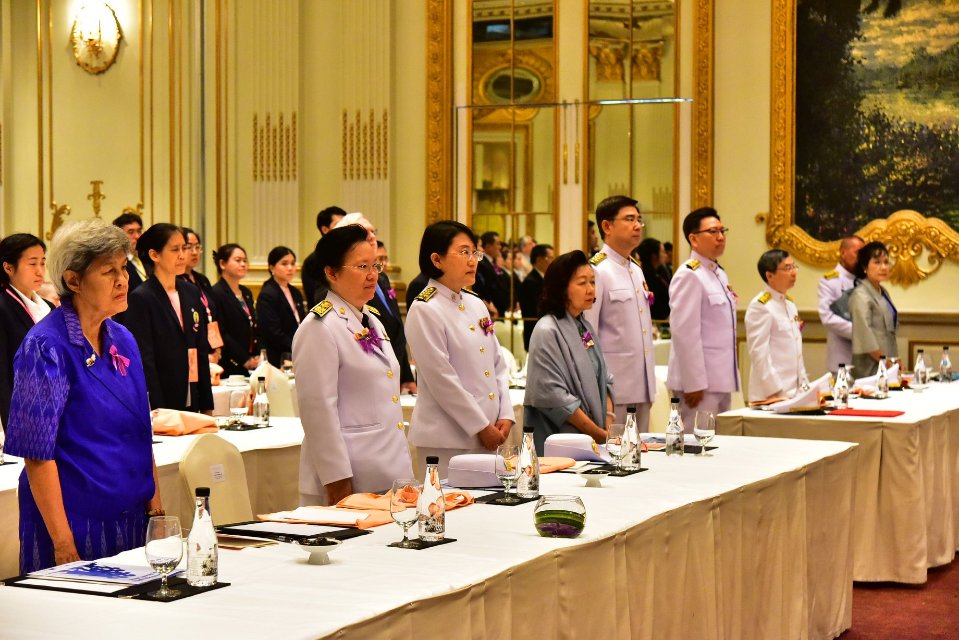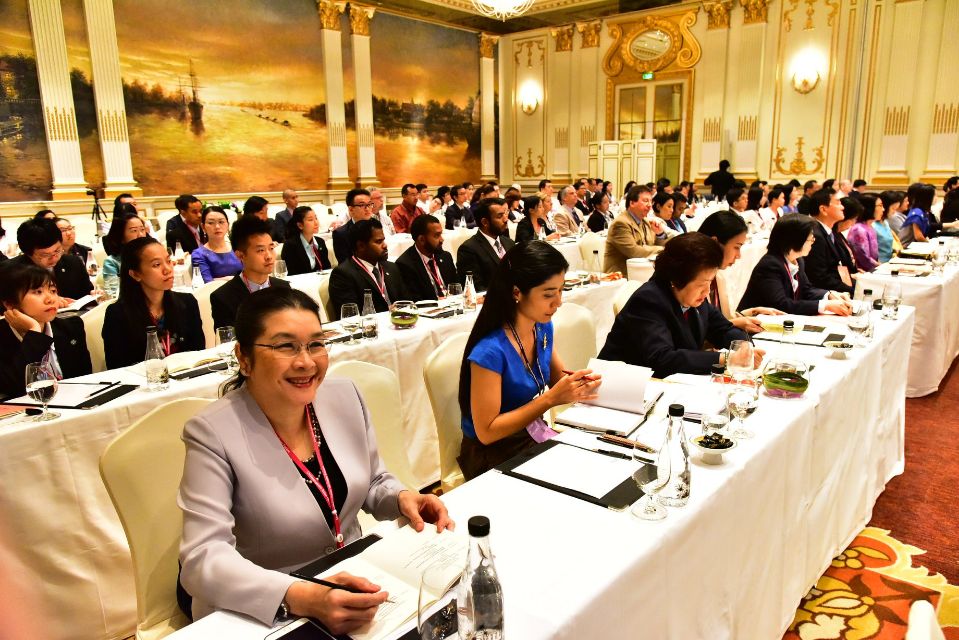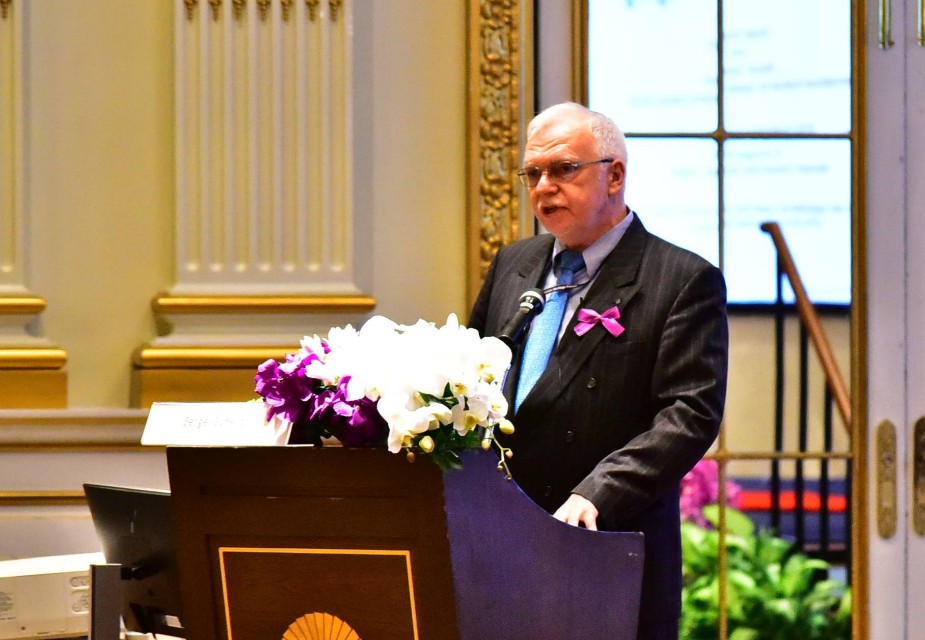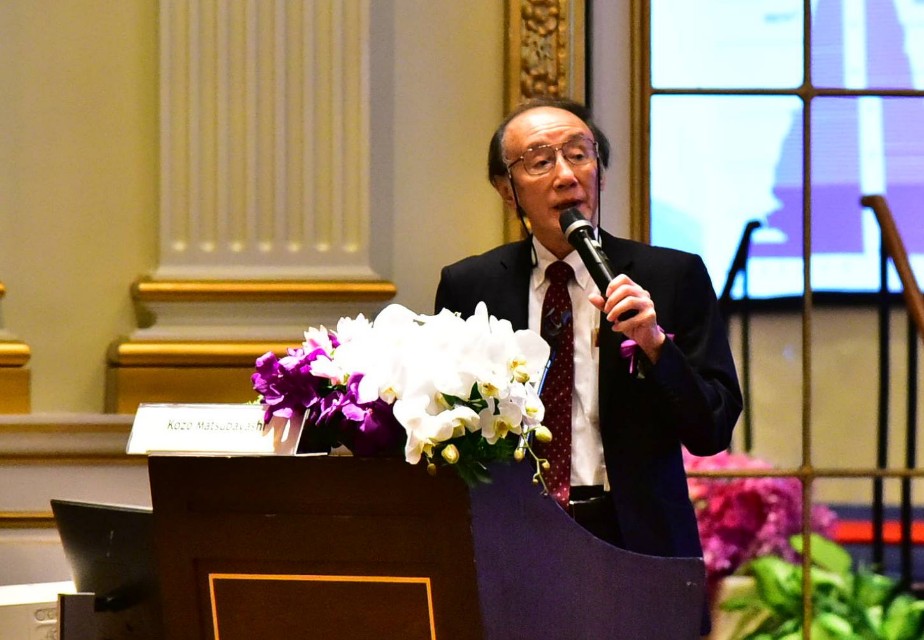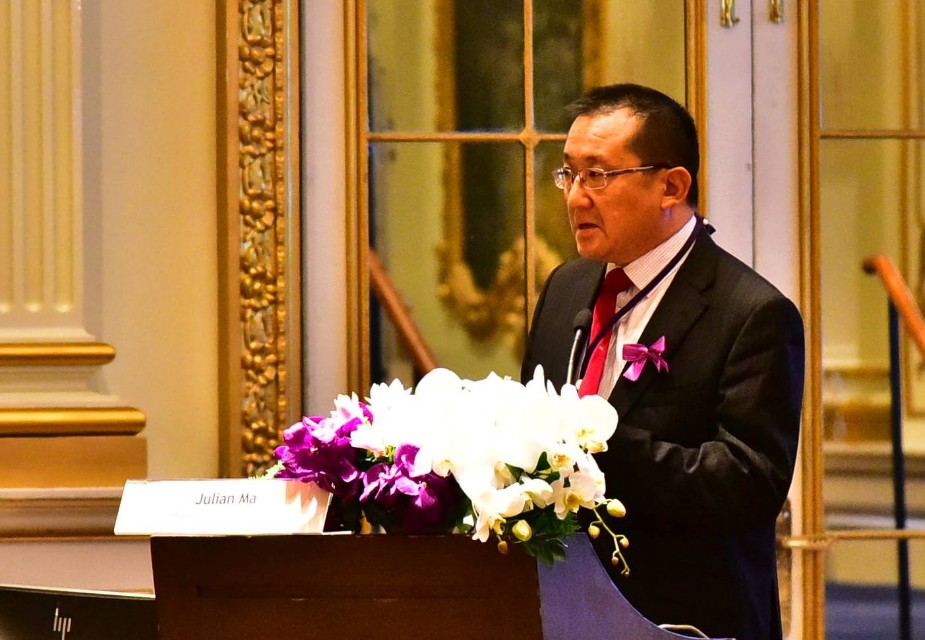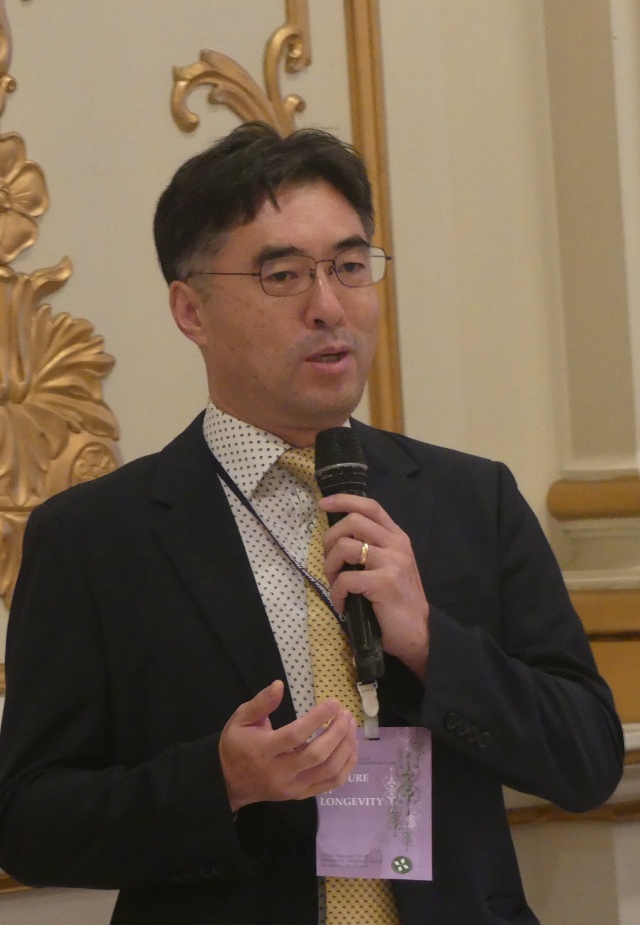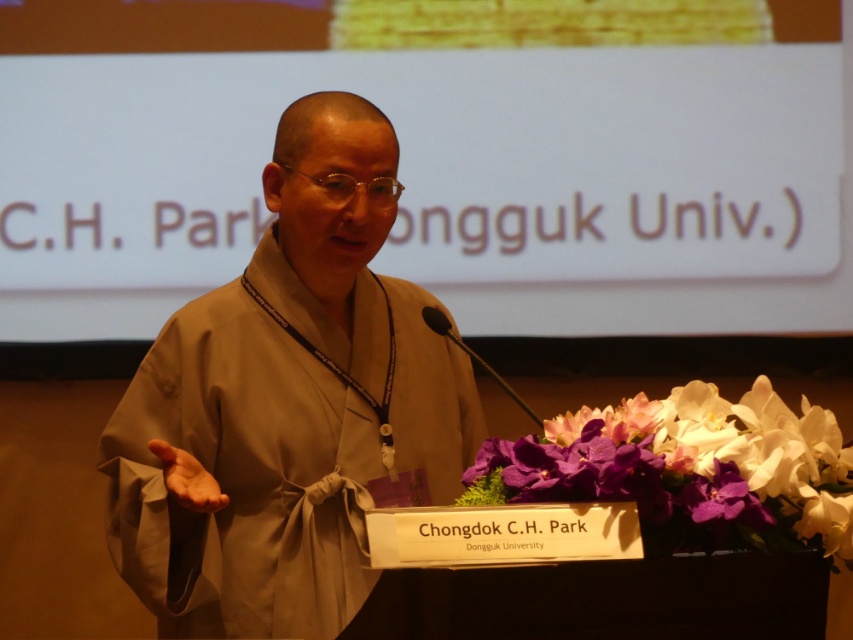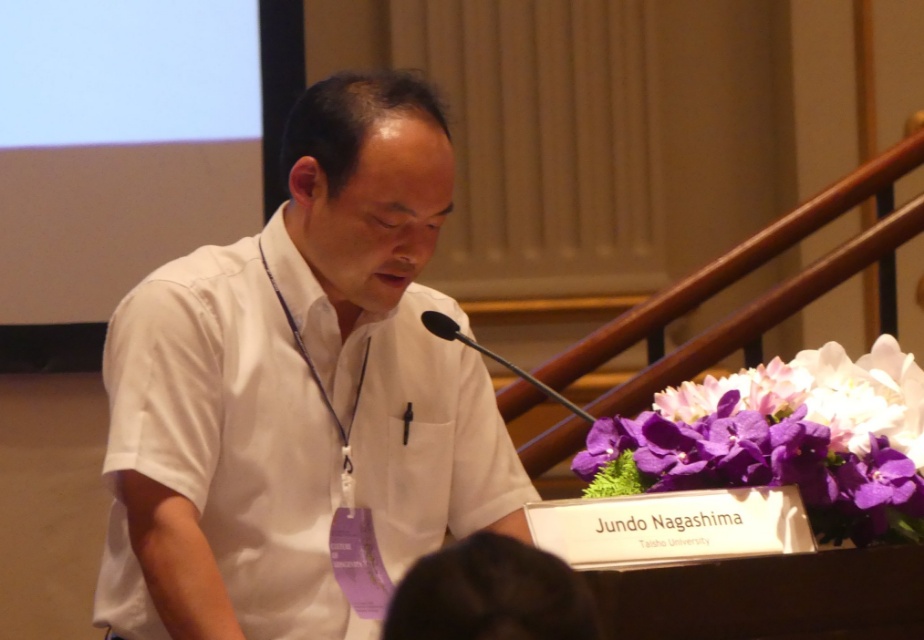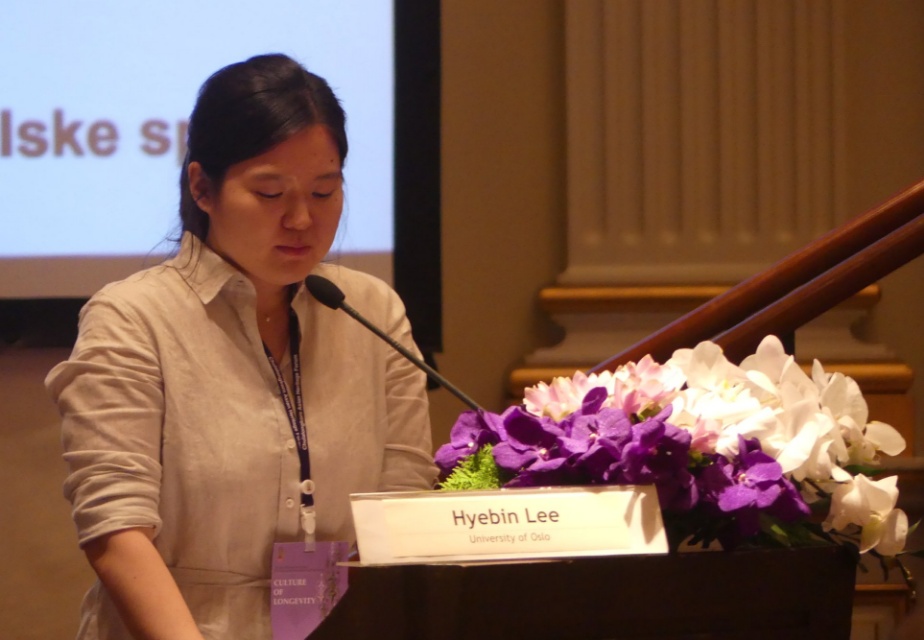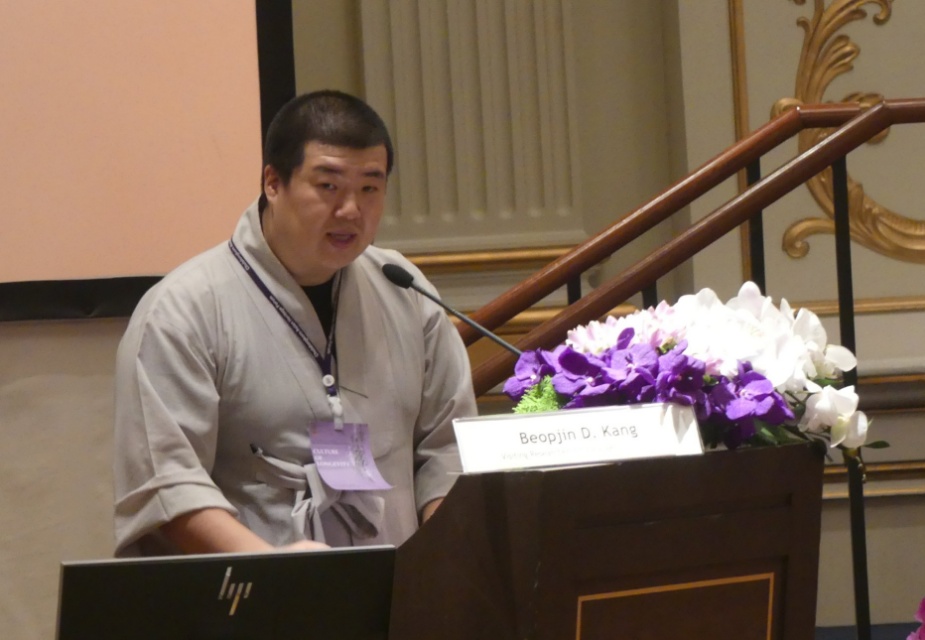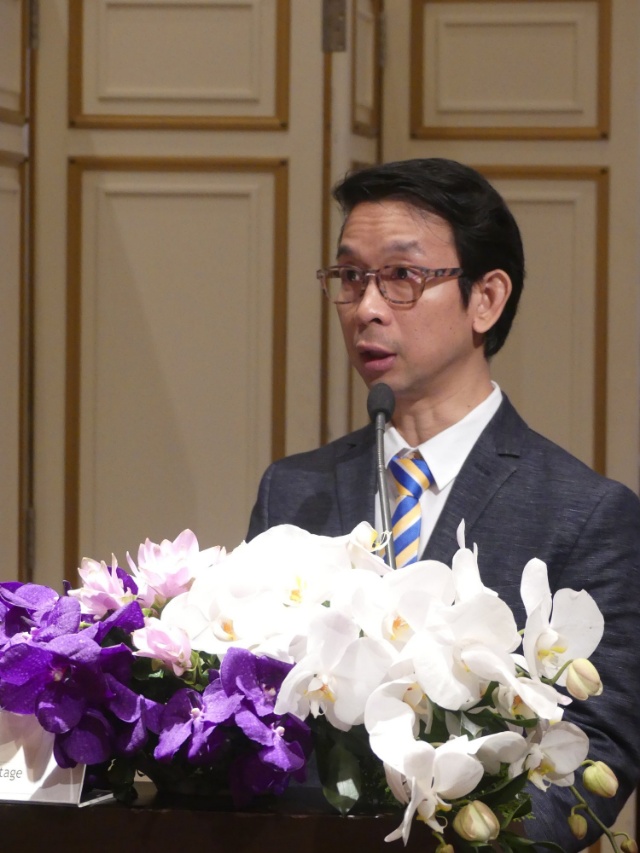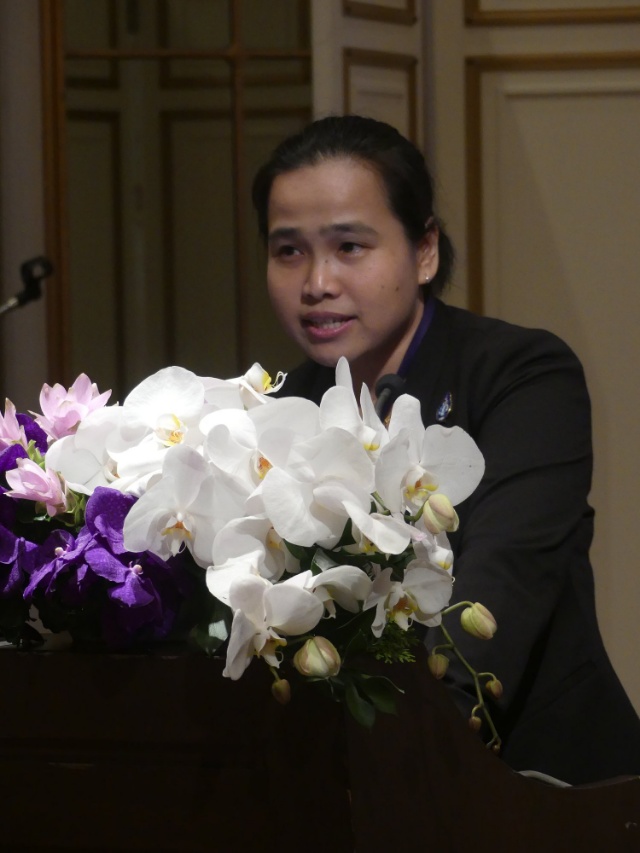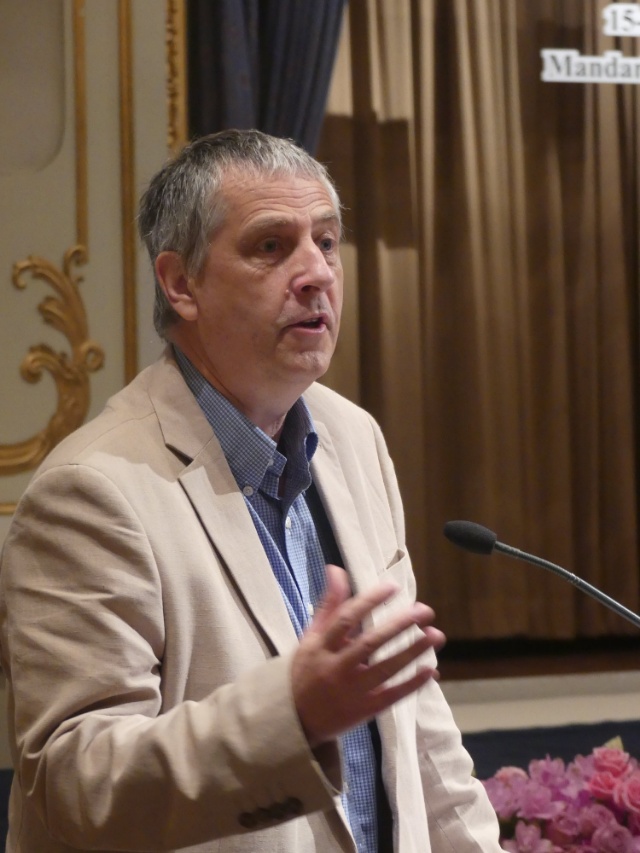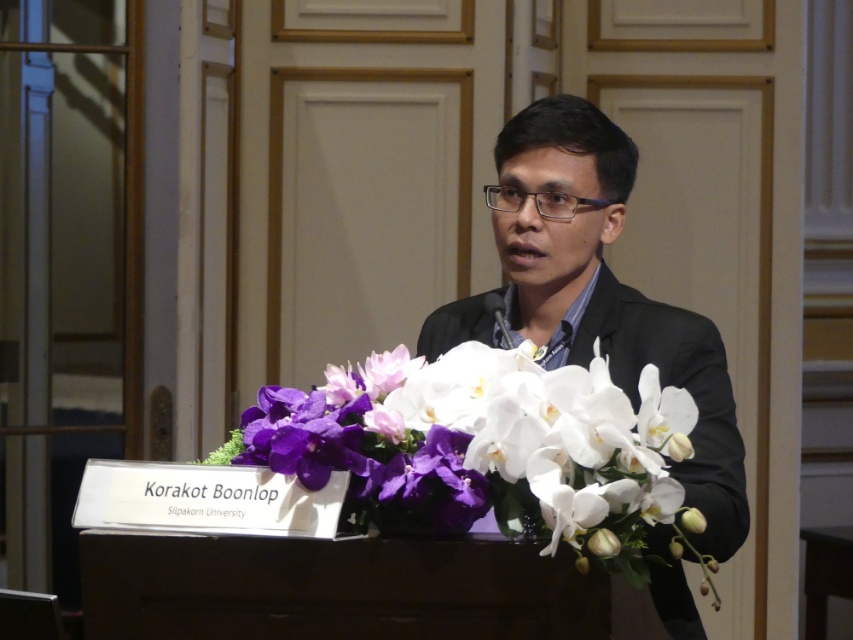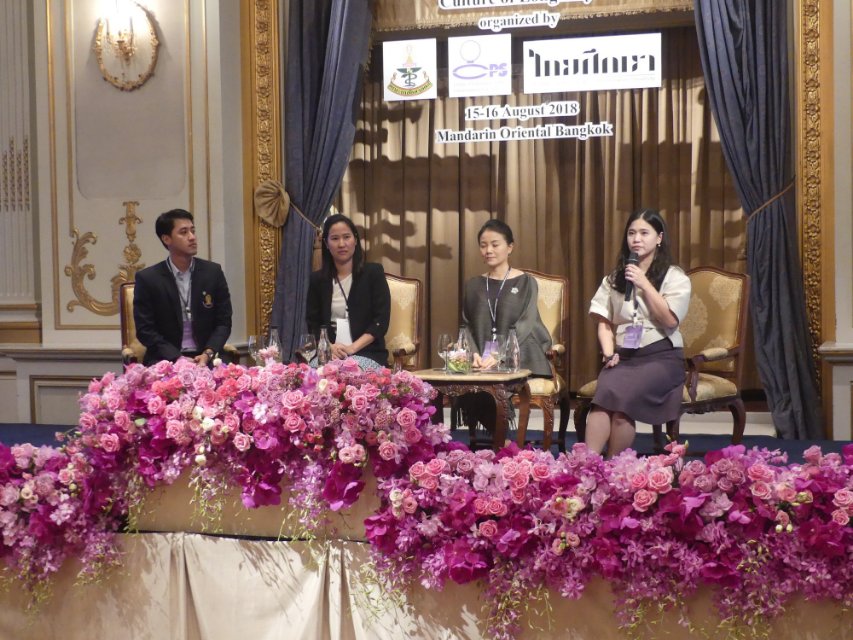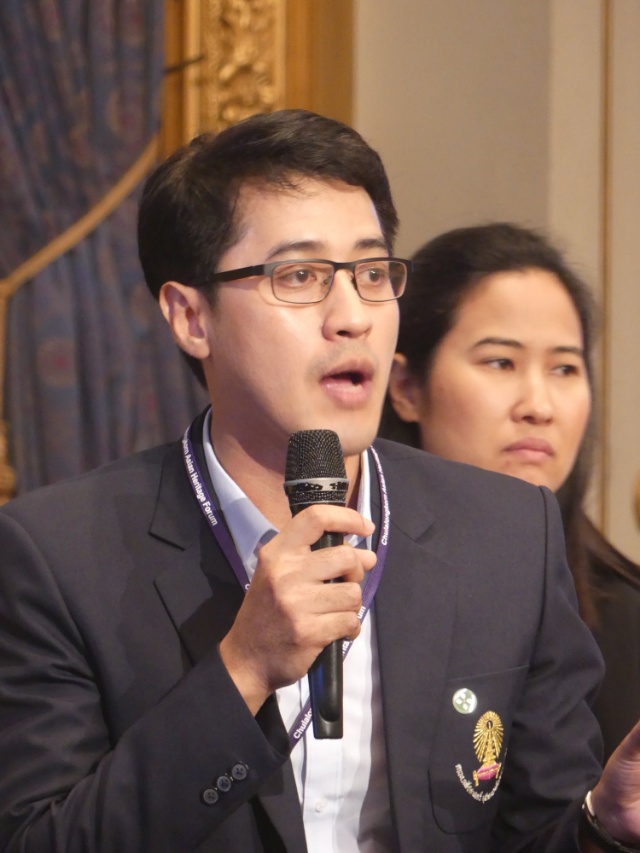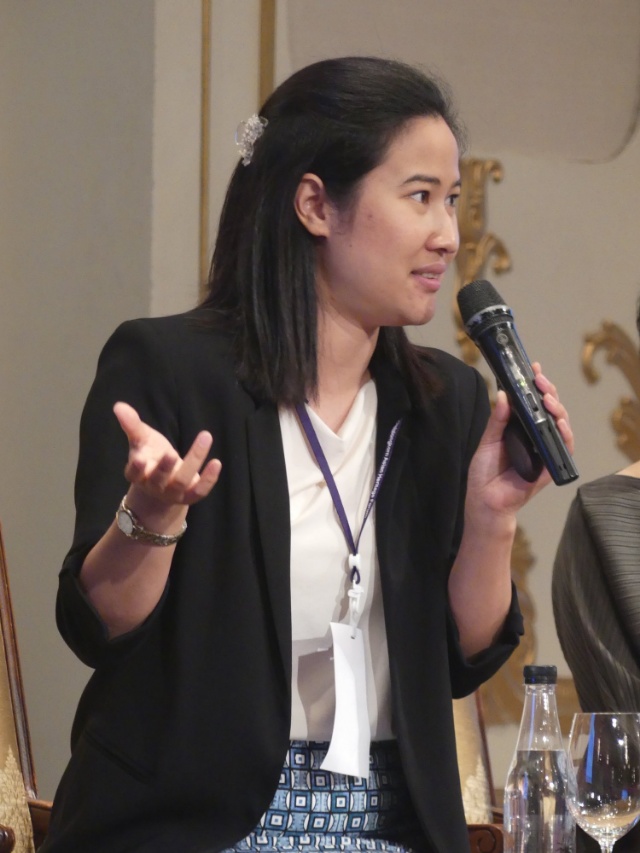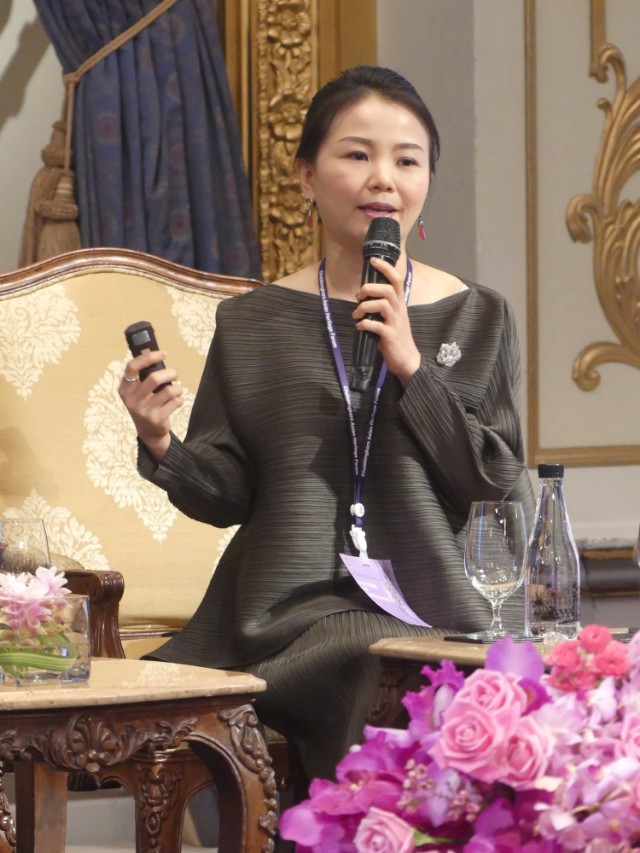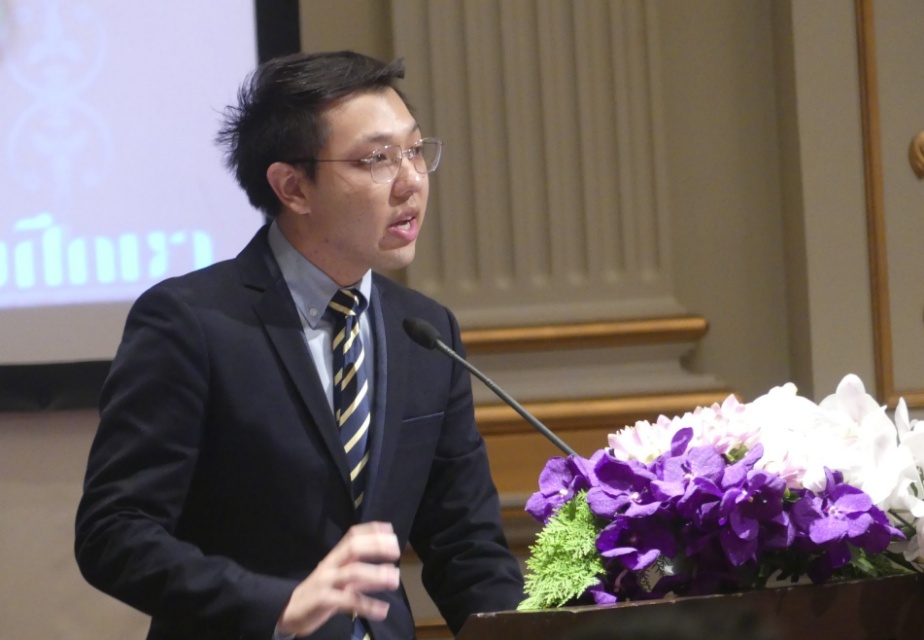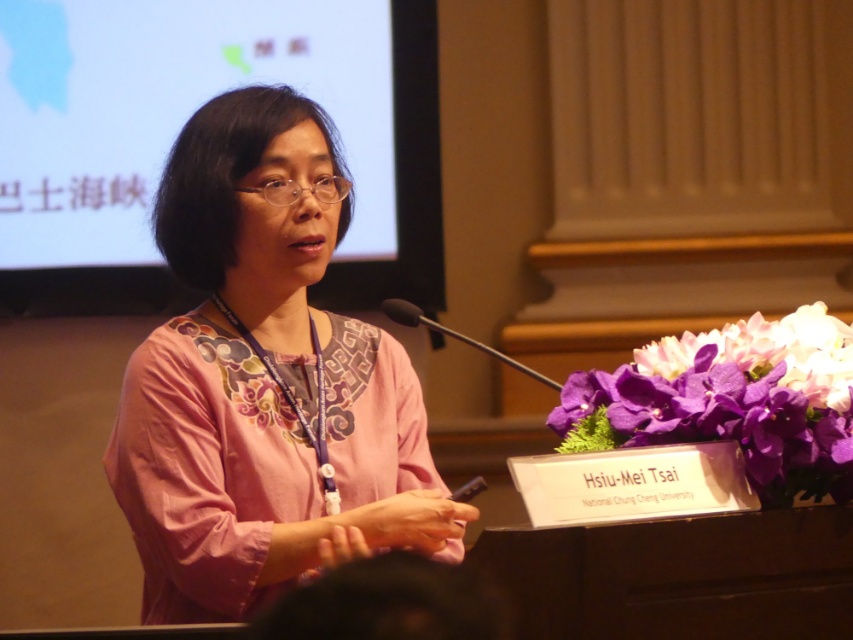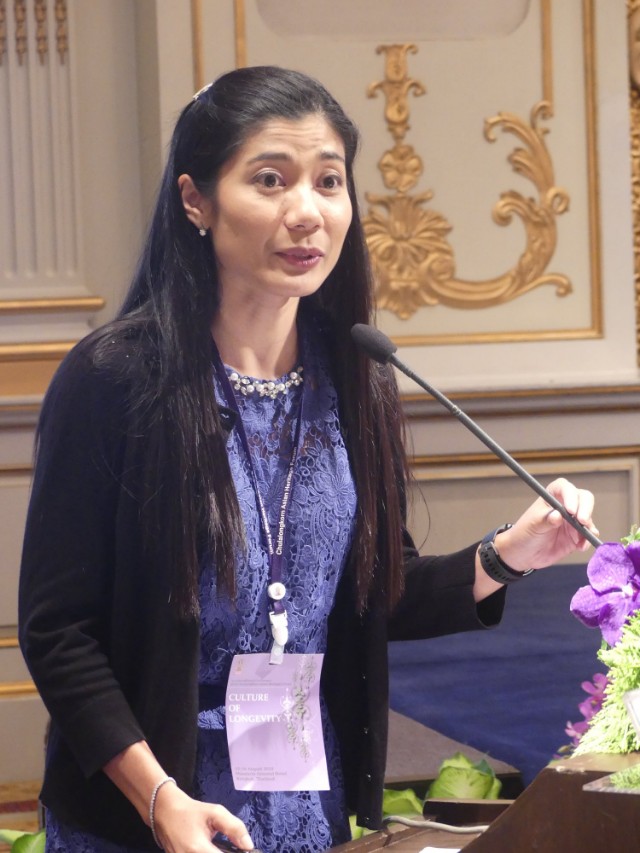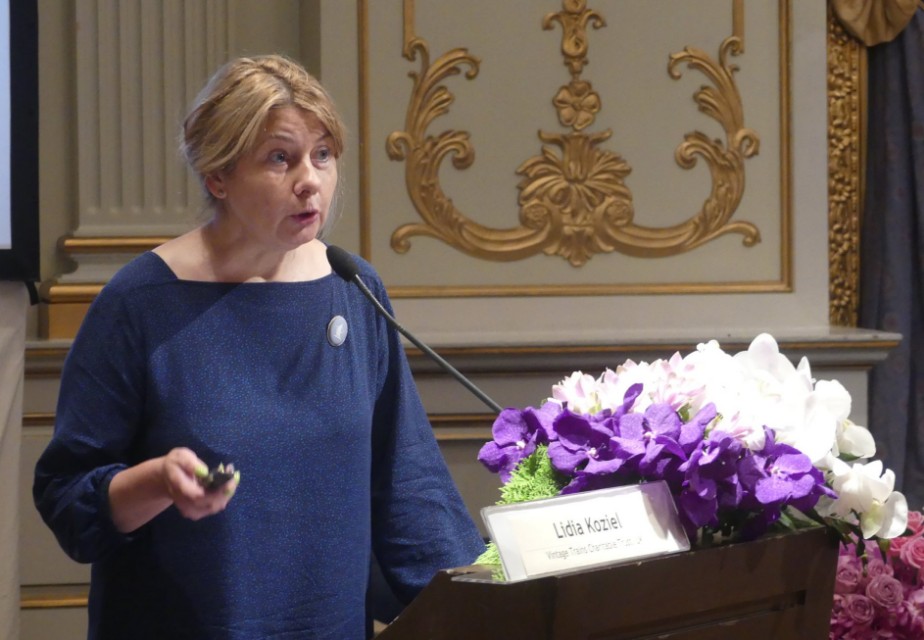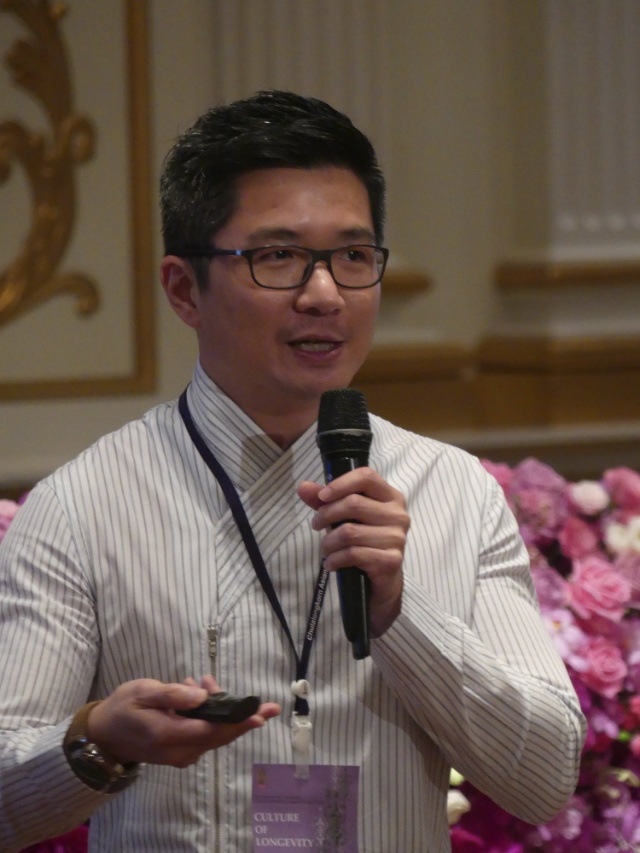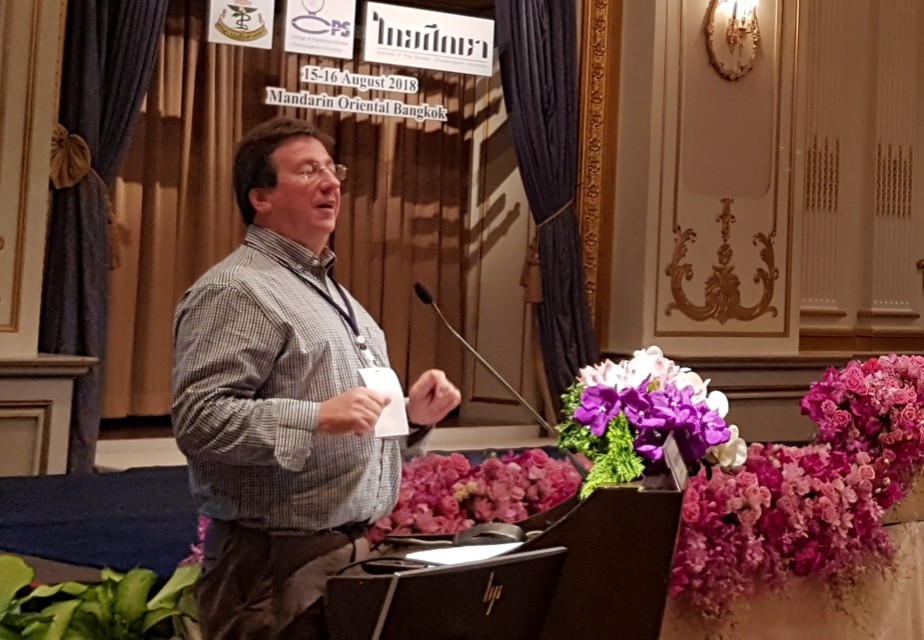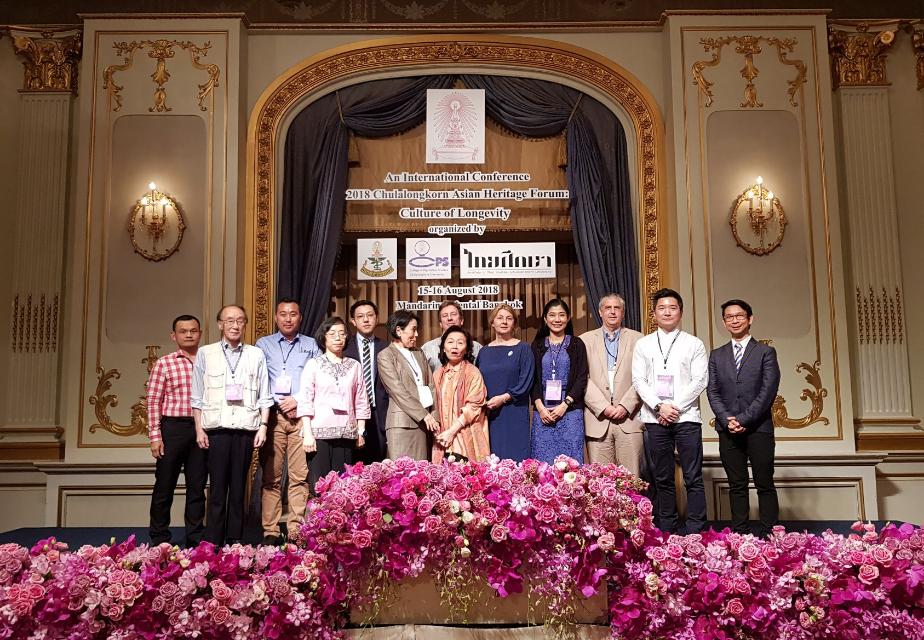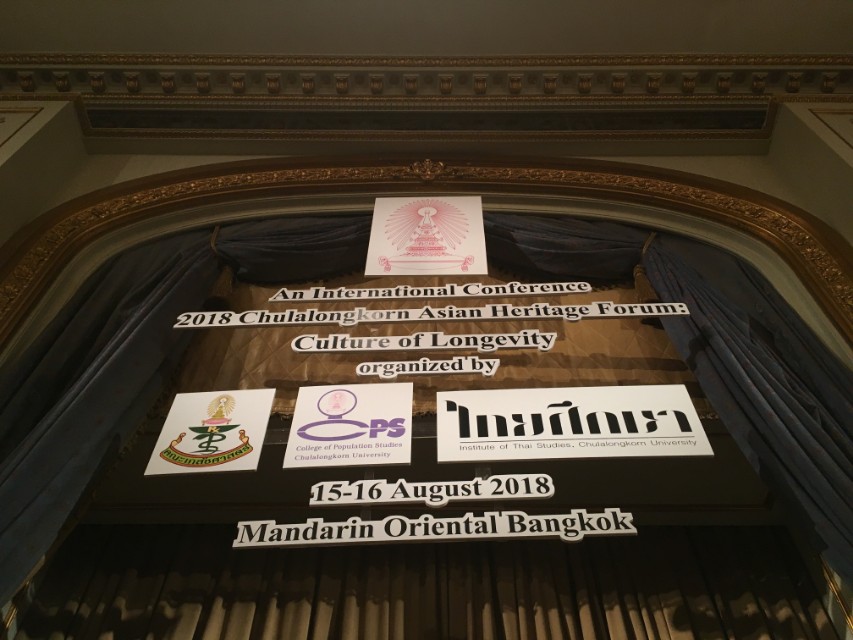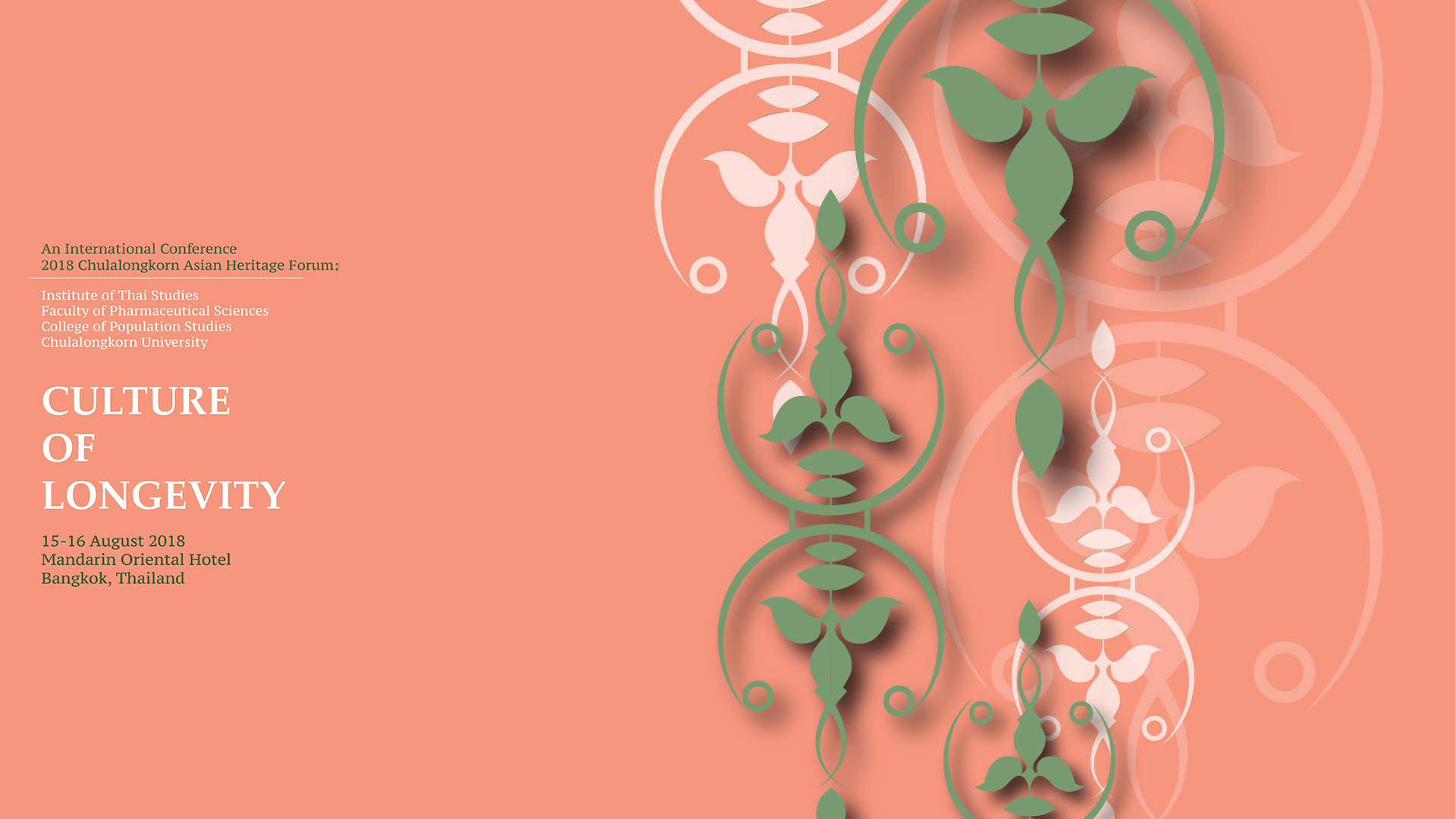Organizer (2018 Chulalongkorn Asian Heritage Forum : Culture of Longevity)
An International Conference
2018 Chulalongkorn Asian Heritage Forum :
CULTURE OF LONGEVITY
15-16 August 2018
Mandarin Oriental Hotel, Bangkok, Thailand
organized by
Institute of Thai Studies
Faculty of Pharmaceutical Sciences
College of Population Studies
Chulalongkorn University
Acknowledgements (2018 Chulalongkorn Asian Heritage Forum : Culture of Longevity)
On behalf of the organizing committee, I would like to express my appreciation for the efforts of the many people and organizations who have contributed to this event.
Sincere appreciation is extended to all the scholars who have graciously accepted to share their wisdom and research expertise in this venue. Their contribution is a genuine reflection of the success of this beneficial conference.
Suchitra Chongstitvatana
Director, Institute of Thai Studies
Chulalongkorn University
Program on 15 August (2018 Chulalongkorn Asian Heritage Forum : Culture of Longevity)
08.00-08.30
Registration
09.00-09.15
Arrival of HRH Princess Maha Chakri Sirindhorn
OPENING CEREMONY
Room: Royal Ballroom
MC: Surapeepan Chatraporn
09.15-09.30
Presentation of a report to HRH Princess Maha Chakri Sirindhorn
Bundhit Eua-arporn
– President of Chulalongkorn University
Opening address by HRH Princess Maha Chakri Sirindhorn
KEYNOTE ADDRESSES
Room: Royal Ballroom
Moderator: Surapeepan Chatraporn
09.30-10.00
New Look on Aging
Sergei Scherbov
– International Institute for Applied Systems Analysis, Austria
10.00-10.30
Holistic Approach towards Aging Study – Asian Perspective
Kozo Matsubayashi
– Kyoto University
10.30-10.40
Intermission
10.40-11.10
Infection and Infectious Disease – The Key to Longevity
Julian Ma
– St George's, University of London
11.10-13.00
Luncheon
LONGEVITY AND BUDDHISM
Room: Grand Ballroom
Convenor: Hwang Soonil
13.00-14.30
Chilseong (Seven Stars), Overseer of Longevity in Korean Buddhism
Chongdok C. H. Park
– Dongguk University
Super-aged Society and Roles of Buddhism in Japan
Jundo Nagashima
– Taisho University
Finding Long Life in the Epic of Gilgamesh in the Mirror of the Dhammapada
Hyebin Lee
– University of Oslo
14.30-15.00
Refreshments
15.00-16.00
Negative Images in a Long Life Deva
Beopjin D. Kang
– Visiting Researcher, Chulalongkorn University
The Cycle of Good Life and Well-Prepared Death in Bongo Village of Southwest Bhutan
Dendup Chopal
– Australian National University
Program on 16 August (2018 Chulalongkorn Asian Heritage Forum : Culture of Longevity)
08.30-09.00
Registration
LONGEVITY AND CULTURAL HERITAGE
Room: Grand Ballroom
Moderator: Bhadravarna Bongsasilp
09.00-10.30
Growing Old Gracefully? The Life and Death of Heritage
Mike Robinson
– Ironbridge International Institute for Cultural Heritage
Conservation as Memory: A Comparative Analysis of Asian and Western Attitudes to Building Conservation
Roger White
– University of Birmingham
Palaeodemography in Thailand from Archaeological Records
Korakot Boonlop
– Silpakorn University
10.30-11.00
Refreshments
PANDEMIC PREPAREDNESS AND HUMAN LONGEVITY
Room: Grand Ballroom
Convenor: Suthira Taychakhoonavudh
11.00-12.30
Panelists
Waranyoo Phoolcharoen
Jittima Luckanagul
Eakachai Prompetchara
– Chulalongkorn University
12.30-13.30
Luncheon
LONGEVITY AND EDUCATION: LEARNING BEYOND SCHOOLS
Room: Grand Ballroom
Convenor: Chawin Pongpajon
13.30-15.00
In Search of Healthy Longevity: Exploring Knowledge and Lifestyles of Active Aging
Hsiu-Mei Tsai
– National Chung Cheng University
A Lifelong Learning Society for All toward Enhancing Sustainable Active and Productive Aging Development in Thailand
Suwithida Charungkaittikul
– Chulalongkorn University
Education in the Time of Longevity
Mariko Yoshida
– Kyoto University
15.00-15.15
Refreshments
15.15-16.45
Informal Learning and Life-Long Education: The Challenges and Benefits of Senior Citizen Participation in Heritage
Lidia Koziel
– Vintage Trains Charitable Trust, UK
Silver Strategies for the Silver Generation
Alvin Tan
– National Heritage Board, Singapore
Aging and Multiculturalism
Stephen McKinney
– University of Glasgow
CLOSING SESSION
Room: Grand Ballroom
MC: Saharat Jatemanorom
16.45-17.00
Closing Address
New Look on Aging
Sergei Scherbov
World Population Program, International Institute for Applied Systems Analysis, Austria
Most studies of population aging focus on only one characteristic of people – their chronological age. For example, the Old Age Dependency Ratio categorizes people as “old” at age 65, regardless of whether they were living 50 years ago or are likely to be living 50 years in the future. However, 65-year-olds today generally have higher remaining life expectancies and are healthier than their counterparts in previous generations. Moreover, people of the same age, but living in different parts of the world, are also very different even at the same age. A 65-years old person living in a country with high life expectancy may differ by health, physical and cognitive characteristics from a person of the same age, but living in a country with low life expectancy. This is because age-specific characteristics of people vary over time and place. Aging is a multidimensional process and focusing only on one aspect of the changes entailed in population aging, but not on all the others, provides a limited picture that is often not appropriate for scientific study or policy analysis.
The presentation is devoted to new ways of measuring aging that more accurately represent the real world. It will be shown that once more adequate measures of aging are used, past aging looks very different and, in countries with high life expectancies, almost no aging was observed. Future aging trends look much less gloomy when new indicators of aging are used as compared to traditional approaches. The recently developed characteristics approach for the study of population aging will be introduced and used in evaluating differences in aging across space and time.
(Presented in the 2018 Chulalongkorn Asian Heritage Forum : Culture of Longevity, 15-16 August 2018, Mandarin Oriental Hotel, Bangkok, organized by Institute of Thai Studies, Faculty of Pharmaceutical Sciences, College of Population Studies, Chulalongkorn University)
Holistic Approach towards Aging Study – Asian Perspective
Kozo Matsubayashi
Center for Southeast Asian Studies, Kyoto University
It is only during the last half century that aging has come to be truly thought of as a societal issue, rather than simply a personal one, as well as a challenge to be tackled by science and medicine. Diseases used to be studied only in hospitals and laboratories, centering on patients treated there. However, caring for elderly people in hospitals provides only a small glimpse into their world. With an advancing aged population, the reality of old age or age-related chronic illnesses takes place in homes and communities. In order to truly understand the health issues of the elderly, we must venture out and visit elderly people in their homes and cultural environments in Asian communities. Based on the geriatric findings of “Field Medicine” carried out on sites where the ecology and culture are different, we reconsider the holistic approach related to activities of daily living and quality of life, as well as chronic diseases of the elderly people in the world.
In this discussion, the concept of a geriatric society and the importance of the 6 “Ds” in geriatric medicine will be reviewed based on field medical findings in Asia, especially based on the viewpoints of human evolution. I would like to bring forward the importance of “Field Medicine” through both space and time.
(Presented in the 2018 Chulalongkorn Asian Heritage Forum : Culture of Longevity, 15-16 August 2018, Mandarin Oriental Hotel, Bangkok, organized by Institute of Thai Studies, Faculty of Pharmaceutical Sciences, College of Population Studies, Chulalongkorn University)
Infection and Infectious Disease – The Key to Longevity
Julian Ma
Institute for Infection and Immunity, St George's, University of London
In the last 50 years, the average life expectancy in Thailand has increased from 58 to 75 years. This mirrors changes that have been observed across the world. The control of infection and infectious disease through antibiotics and vaccines is undoubtedly a key factor in this outstanding change, and in the West, where infections once caused about 50% of deaths, they now barely register in the top ten causes of death. However, there remains a discrepancy between the health expectations of people in the most developed regions as compared with those in less developed regions, for example, in the USA and Europe, the average life expectancy is about 80 years.
Controlling infections is so pivotal to global health, that now, with the rise of antimicrobial resistance and increasing difficulty in preventing or controlling infections, perhaps one of the biggest threats to human health is the emergence of drug resistant infectious diseases.
This talk will explore two related aspects of infection, longevity and global health; specifically how to address the increasing problem of AMR and how to ensure that these approaches are accessible and affordable for everyone.
(Presented in the 2018 Chulalongkorn Asian Heritage Forum : Culture of Longevity, 15-16 August 2018, Mandarin Oriental Hotel, Bangkok, organized by Institute of Thai Studies, Faculty of Pharmaceutical Sciences, College of Population Studies, Chulalongkorn University)
Chilseong (Seven Stars), Overseer of Longevity in Korean Buddhism
Chongdok C. H. Park
Dongguk University
Chilseong, or Seven Stars, is a deification of the constellation Bukduchilseong (Big Dipper), overseeing health and longevity, personal wishes, peace and safety, and most of all, longevity of children. Chilseong worship is one of the oldest practices in Korean folk religion, observed by women in the form of private household rituals with an offering of fresh water from the well (jeonghwasu), or by shamans in the form of chilseonggut, or the Seven Stars ritual.
In Taoism, Chilseong is believed to oversee the fortunes of individuals, called Chilseongyeorae (Seven Stars Buddha) or Chiraseonggun (Seven Star Gods). At Korean Buddhist temples, Chilseong is enshrined as an adapted version combined with the medicine Buddha, Yaksayeorae (Bhaisajya-guru), promoting faith in the afterlife. Chilseong shrines became a part of Buddhist temples in Korea because Sansin (Mountain God) worship and Chilseong worship were the two most important folk beliefs at the time of the introduction of Buddhism, and the adaptation of Chilseong was especially crucial since the deity oversees the lifespan of individuals. Within this historical context, Chilseong worship spread around the country, combining folk religion with Buddhism and Taoism.
(Presented in the 2018 Chulalongkorn Asian Heritage Forum : Culture of Longevity, 15-16 August 2018, Mandarin Oriental Hotel, Bangkok, organized by Institute of Thai Studies, Faculty of Pharmaceutical Sciences, College of Population Studies, Chulalongkorn University)
Super-aged Society and Roles of Buddhism in Japan
Jundo Nagashima
Taisho University
Life expectancy in Japan was about 45 years in 1935 and reached 83.2 in 2015. In 2007, Japan entered the level of a super-aged society, where the population of 65 years or older accounted for over 21%. This aging rate now stands at 26%. This means that people in Japan have more time to process the idea of death and dying than 80 years ago when they tended to pass away while being relatively more active. It is also said that aging and religiosity have a correlative relationship. As a result, it is increasingly necessary for Japanese religions, especially Buddhism, to provide wisdom so that elderly people live comfortably towards the end of their lives.
This tendency, on the other hand, has created problems. One of them is the trend away from religion among young adults because of the generation gap caused by elderly-oriented religious activities. Moreover, some temples are suffering from a lack of successors and have difficulty in management.
Although a super-aged society is likely to be in favor of Japanese religion for the time being, the following generations are not necessarily going to be as religious and it is almost inevitable that Japanese population will decrease by almost half in the coming 100 years. Therefore, in this presentation, I would like to show the gravity of an aging population and discuss related issues surrounding Buddhism in Japan.
(Presented in the 2018 Chulalongkorn Asian Heritage Forum : Culture of Longevity, 15-16 August 2018, Mandarin Oriental Hotel, Bangkok, organized by Institute of Thai Studies, Faculty of Pharmaceutical Sciences, College of Population Studies, Chulalongkorn University)
Finding Long Life in the Epic of Gilgamesh in the Mirror of the Dhammapada
Lee Hyebin
PhD Candidate, University of Oslo
Death is our inescapable destiny; yet nobody wants to accept that. Mankind has always questioned death, and immortality has been a wish for a long time. We can find many examples to overcome our inevitable destiny in the religious scriptures, as well as historiography, literature and the arts.
The epic of Gilgamesh, one of the oldest poems written in the Akkadian during the late second millennium BC, is about the journey of the heroic king of Uruk, Gilgamesh, looking for immortality. This epic has been an inexhaustible source for classical and modern literature around the world. In this epic poem, after witnessing the death of his beloved friend, Gilgamesh tries to find a way to have a long life from his demigod ancestor. When his journey comes to failure, he stops all endeavors to get an immortal life, and finds the answer not in the individual, but in the community.
The Dhammapada, which can be translated into “the words of the doctrine”, is one of the oldest pieces of Buddhist literature complied at a very early period. The scripture, based on the widely used Pāli Dhammapada, is composed of 423 verses in 26 vaggas. The contents of verses are not the Buddhist doctrine, but are “gnomic verses”. This text has been transmitted into most Buddhist traditions, such as Theravāda, Mahāyāna and Tibetan Buddhism.
This presentation will compare the answer of seeking long life in the Epic of Gilgamesh with that of the Dhammapada. Gilgamesh could get the answer from the outside, while Buddhism encourages people to achieve their answers from the inside. In particular, I will present some verses in the Dhammapada that give us the teaching of a long life by dividing into three categories: the axiom, the way to reach immortality and the true meaning of immortality.
(Presented in the 2018 Chulalongkorn Asian Heritage Forum : Culture of Longevity, 15-16 August 2018, Mandarin Oriental Hotel, Bangkok, organized by Institute of Thai Studies, Faculty of Pharmaceutical Sciences, College of Population Studies, Chulalongkorn University)
Negative Images in a Long Life Deva
Beopjin D. Kang
Visiting Researcher, Chulalongkorn University
In Indian thought, time does not exist on a straight line; rather it is conceived as a circle. Even though we may stay a long time in one place, and stay a short time in another place, eventually “time” is a cycle or cakra. Cakra has other meanings, apart from the Buddha’s teachings, and is considered the circle of our life. Indian people refer to this as samsara (rebirth)
The various places we visit along our cosmological timeline include the Desire Realm/world, the Form Realm or Formless Realm. One of these, the 4th heaven, the 12th or 13th heaven in the Form Realm, is called the “long life gods” – their lifetime is about 500 kalpa.
However, it is not exactly known exactly which one is a “long life god” because every heaven in the three worlds includes long life. Hence, the Mahayana text, Mahāprajñāpāramitā-śāstra, defines this differently in various versions.
Long life devas exist in the Form Realm. They are higher than human beings, but their life is also under a limited timeline. Of particular importance, they feel happy about their long life in the world, and because of this happiness, they are unable to reach enlightenment and become a buddha also. They have too secular a view of happiness to graduate into buddhahood through enlightenment.
As for the cakra, the world’s idea of happiness being long life, or even eternal life/immortality, sometimes carries a very negative image in Buddhism. Classical examples say that immortality, the elixir of life, is a metaphor for the Buddha’s teachings. However, Chinese translators have translated this as “sweet dew”, meaning nectar related to the drink of the gods. They do not use the term “immortal”.
It is indeed interesting that the concepts of time (cakra), long life and immortality (amata) are examples of metaphors for the Buddha’s teachings; however sometimes they express negative images in the context of Buddhist enlightenment.
(Presented in the 2018 Chulalongkorn Asian Heritage Forum : Culture of Longevity, 15-16 August 2018, Mandarin Oriental Hotel, Bangkok, organized by Institute of Thai Studies, Faculty of Pharmaceutical Sciences, College of Population Studies, Chulalongkorn University)
The Cycle of Good Life and Well-Prepared Death in Bongo Village of Southwest Bhutan
Dendup Chophel
PhD Candidate, College of Arts and Social Science, Australian National University
Preparing for a good death is the primary focus of life in Bongo village. Based on a detailed ethnographic study carried over one year for a PhD dissertation, this paper presents findings on the cyclic nature of life in this rural Bhutanese community, where as soon as a child is born, they are considered a part of the four cycles of existence leading to birth, aging, sickness and death. An ideal life is one in which people consciously follow thoughts and actions that are considered appropriate for each of these cycles. All these stages are considered inevitable, as indeed they are. Therefore, instead of fearing the consequences of birth, aging, sickness and death, approaches to a well-lived life is explored through these life stages. In the changing milieu of Bongo, this means resorting to both traditional and modern life practices. It also means overcoming challenges accruing from these two sources.
This paper deals with how the people seek to align their life goals with these ideal-types, although quite often, they face issues that complicate this process. For example, the ideal-type of existence is based on an historical existence, while their life challenges are contemporary in nature. Thus, there exists a gap between the ideals and actual practices of a full life-lived well, which, however, does not detract them from the qualitative and quantitative pursuits of life.
(Presented in the 2018 Chulalongkorn Asian Heritage Forum : Culture of Longevity, 15-16 August 2018, Mandarin Oriental Hotel, Bangkok, organized by Institute of Thai Studies, Faculty of Pharmaceutical Sciences, College of Population Studies, Chulalongkorn University)
Growing Old Gracefully? The Life and Death of Heritage
Mike Robinson
Ironbridge International Institute for Cultural Heritage
Heritage is an ever expanding category that includes not only the tangible built and natural environments, but also the intangible world of rituals, practices and the like. It appears that the heritage that surrounds us is always present and will remain when we have passed on. Indeed the inter-generational persistence of heritage – its capacity to remain and outlive generations – is one of the elements that defines it. Of course, heritage grows old too and in ways that we do not often understand or appreciate. Buildings need to be maintained as they show their signs of aging and maintenance costs can be very high forcing us to consider the benefits of their “being in the world”. Indeed, some of these benefits relate to helping us cope with our own aging. Critically, the relationships that we share with the heritage around us also changes and this too forces us to address the question of how long do we keep our heritage alive.
Taking note of the different approaches between European and Asian cultures, in this presentation, I raise some moral questions surrounding how and why societies allow heritage to grow old and ask: Is this good for society? Is this good for heritage? Should we not allow some heritage to die and, if so, on what basis do we decide this? How do we calculate the good that heritage can generate and how does that benefit the human condition of aging?
I argue that we need to re-think what heritage does for our communities and societies with regard to both past and future generations and that the concept of rebirth is helpful in assisting us in allowing some of our heritage to die.
(Presented in the 2018 Chulalongkorn Asian Heritage Forum : Culture of Longevity, 15-16 August 2018, Mandarin Oriental Hotel, Bangkok, organized by Institute of Thai Studies, Faculty of Pharmaceutical Sciences, College of Population Studies, Chulalongkorn University)
Conservation as Memory : A Comparative Analysis of Asian and Western Attitudes to Building Conservation
Roger White
College of Arts and Law, University of Birmingham
As is well known, approaches to building conservation until 1994 were dominated by a Western-oriented perspective that reified the fabric of buildings so that each phase of a building’s history could be read in its own right. In 1994, the Nara Document was issued offering a completely different cultural perspective on the conservation of buildings. This presented an approach that sees conservation as a means to preserve not the fabric of a building, but its constructional authenticity. In other words, it is not important to retain the components of a building, but to replace them exactly if that is necessary to preserve the structural integrity of the building. This principle has now been enshrined and validated as an equally valid conservation approach.
My purpose in this lecture is to talk about another approach that belongs to antiquity, but which represents a distinctive strand in building conservation: the use of “spolia” in buildings. Spolia is a term used to describe the recycling of architectural materials into a new building in a way that leaves the embedded elements visible and intelligible. As a practice, it was used in ancient Rome, but is very characteristic of the Middle Ages in Europe. This paper explores why such an approach was used, what it tells us of ancient attitudes to buildings, and how it contrasts with the approach used in the Nara Declaration.
(Presented in the 2018 Chulalongkorn Asian Heritage Forum : Culture of Longevity, 15-16 August 2018, Mandarin Oriental Hotel, Bangkok, organized by Institute of Thai Studies, Faculty of Pharmaceutical Sciences, College of Population Studies, Chulalongkorn University)
Palaeodemography in Thailand from Archaeological Records
Korakot Boonlop
Department of Archaeology, Silpakorn University
Longevity can be estimated archaeologically and directly from human skeletal remains. The data from such estimates is potentially applied for understanding history and changing longevity trends among the population in Thailand since the remote past.
This paper aims to present palaeodemographic data from different groups of prehistoric populations in Thailand. Those groups are the prehistoric people from Non Nok Tha, Non Pa Kluai in Khon Kaen, Ban Chiang, Ban Na Di in Udon Thani, Non Prao in Nong Bua Lum Phu, Ban Khok Khon in Sakon Nakhon. These sites are located on the Khorat Plateau in the northeast region of Thailand. In addition to those population groups, Khok Phnom Di in Chon Buri, from the eastern coastal area of the country, is another site that is included.
The palaeodemographic data in this paper is presented as an “abridge life table”. This table is based on numerical data from an estimate of age-at-death of those prehistoric populations. Age-at-death is normally estimated from the archaeological human remains in order to construct a biological and palaeodemographic profile of the past population. An estimate relies on the standard methods and techniques of bioarchaeology and physical biological anthropology. Macroscopic analysis is the main method for such investigation on ancient human skeletons. Extra methods, radiography in particular, are also applied to the investigation in specific cases. A palaeodemographic profile, especially an abridge life table, is a proxy to estimate the quality of life of those ancient populations who settled in the area of present day area of Thailand since approximately 5,000 years before the present.
(Presented in the 2018 Chulalongkorn Asian Heritage Forum : Culture of Longevity, 15-16 August 2018, Mandarin Oriental Hotel, Bangkok, organized by Institute of Thai Studies, Faculty of Pharmaceutical Sciences, College of Population Studies, Chulalongkorn University)
Pandemic Preparedness and Human Longevity
Suthira Taychakhoonavudh
Waranyoo Phoolcharoen
Jittima Luckanagul
Eakachai Prompetchara
Faculty of Pharmaceutical Sciences, Chulalongkorn University
With the continued increase in life expectancy, the need for complex healthcare intervention to facilitate “healthy aging” also increases. The risk of emerging infectious diseases and the potential to cause a pandemic is a significant threat for an aging society in countries all over the world. Low to middle-income countries are more affected by these threats as capacity to handle such epidemics are much lower.
This panel discussion will address several biotechnologies aimed to mitigate these issues with the potential for implementation in low to middle-income countries, such as Thailand.
(Presented in the 2018 Chulalongkorn Asian Heritage Forum : Culture of Longevity, 15-16 August 2018, Mandarin Oriental Hotel, Bangkok, organized by Institute of Thai Studies, Faculty of Pharmaceutical Sciences, College of Population Studies, Chulalongkorn University)
In Search of Healthy Longevity : Exploring Knowledge and Lifestyles of Active Aging
Hsiu-Mei Tsai
National Chung Cheng University
For the first time in the history of humankind, people can expect to live a long life beyond the life expectancy of their grandparents. However, somehow the issue of an aging society seems to be more terrifying than something blessed, especially issues from medical, social, economic and intergenerational aspects. Are we prepared for the coming of an aged society, both at personal or society levels? What are the new knowledge, attitudes and lifestyles that bring about healthy and happy longevity? How can people learn the way to healthy longevity? These are important questions that need to be addressed.
In this paper, I will propose the idea of “healthy longevity” by exploring knowledge, attitudes and behavior that accompany the idea of “active aging”. First, we should recognize the trend of population aging globally and locally. Second, some challenges of an aged society will be discussed. Third, I will address the idea of active aging and present the knowledge, attitudes and lifestyles related to health longevity. Novel knowledge and suggested lifestyles may come from research across medical, psychological, sociological and gerontological fields. Finally, I will add some thoughts on longevity under influences from Eastern and Western culture and make some conclusions.
(Presented in the 2018 Chulalongkorn Asian Heritage Forum : Culture of Longevity, 15-16 August 2018, Mandarin Oriental Hotel, Bangkok, organized by Institute of Thai Studies, Faculty of Pharmaceutical Sciences, College of Population Studies, Chulalongkorn University)
A Lifelong Learning Society for All toward Enhancing Sustainable Active and Productive Aging Development in Thailand
Suwithida Charungkaittikul
Faculty of Education, Chulalongkorn University
Amid a changing society and continued development in the 21st century, many countries have identified strategies to deal with the potential changes. Lifelong learning has become one of the overarching values and principles behind many education system reforms. Thailand has been actively using the concept of lifelong learning to help communities, cities and regions move toward becoming lifelong learning societies engaged in a sustainable development strategy that promotes the unending learning of individuals – the smallest unit of society. These activities have aimed to develop appropriate manpower to move society toward sustainable happiness.
This article presents the results of an in-depth research study using the Ethnographic Delphi Futures Research (EDFR) technique to propose a feasible learning society model. This proposed learning society model includes five essential elements: components, principles, developmental processes, strategies and key success factors that can enhance sustainable lifelong learning development. It is anticipated that the findings may help raise local and global citizen awareness with respect to transforming educational institutions, communities, cities and regions into learning societies; foster lifelong learning for all in a more sustainable way at the practical level; guide enhanced quality of national education and learning; benefit interested individuals; and serve as a basis for conducting further research on the subject.
(Presented in the 2018 Chulalongkorn Asian Heritage Forum : Culture of Longevity, 15-16 August 2018, Mandarin Oriental Hotel, Bangkok, organized by Institute of Thai Studies, Faculty of Pharmaceutical Sciences, College of Population Studies, Chulalongkorn University)
Education in the Time of Longevity
Mariko Yoshida
Institute for Liberal Arts and Sciences, Kyoto University
Japan has now the highest life expectancy at birth in the world. This is a realization of what many dreamed of in the past. However, such longevity is perceived rather as a curse today because grave political issues posed by this demographic shift are constantly conveyed in the media. This includes financing the pension system and rising medical care costs, as well as securing enough labor to maintain the economy. A one-sided view of the elderly, akin to “they’ve accomplished their roles and are merely objects of societal burden”, could come to stay as a bias. While elderly people in good health have been increasing in number, many are actively contributing to their communities. The social awareness campaigns should help people recognize life after retirement appropriately and re-design their lives with a positive outlook on the future.
OECD Statistics Working Paper 2017 shows the inequalities in longevity by education. Furthermore, in Japan some research has explored the correlation between health and social factors, such as education, income, occupation and social status, but also with social capital that is based on networks, trust in the community and norms of reciprocity with shared values and mutual understanding.
This presentation attempts to show the summarized results of the studies in Japan and to suggest, based on these, what the roles and functions of a lifelong education in the time of longevity could be, and how they could be implemented. The presentation will also touch on what could be changed in its contents and methods, how learning programs could be developed, as well as what kind of tasks the administration could fulfil in this new context. Finally, education should be deployed exactly where it effectively supports keeping people’s long life healthy, joyful and valued.
(Presented in the 2018 Chulalongkorn Asian Heritage Forum : Culture of Longevity, 15-16 August 2018, Mandarin Oriental Hotel, Bangkok, organized by Institute of Thai Studies, Faculty of Pharmaceutical Sciences, College of Population Studies, Chulalongkorn University)
Informal Learning and Life-Long Education : The Challenges and Benefits of Senior Citizen Participation in Heritage
Lidia Koziel
Vintage Trains Charitable Trust, UK
Through a combination of declining birth rates and increased life expectancy, societies are aging. There is no doubt that this brings with it many challenges in terms of health and social care. However, while many societies continue to focus on the potential problems and costs of caring for their old people, they have a valuable role to play in social and cultural life and, in particular, helping younger generations better understand the world, appreciate its heritage and culture and become better citizens. These are lessons that are often not communicated through formal school education, but rather through processes of learning outside the classroom.
This presentation reports on a project carried out in the European Union to examine the role of senior citizens in the interpretation of cultural heritage sites. The project looked at people over the age of 55 and their role as active citizens who can often influence the opinions of others. The project looked at the ways in which informal learning benefitted seniors, but also considered how these seniors could provide benefit to the wider community. Heritage was found to play a central role in stimulating interaction across and between different cultures and generations.
While this project was drawn from European examples, it has relevance to Asian societies where there are issues surrounding aging populations, particularly in rural areas that have suffered from outward migration. There are still tremendous opportunities through informal learning to mobilise the talents and experience of senior citizens so that they are recognised for what they can bring to social and cultural life, the local economy and a better understanding of the world for younger generations.
(Presented in the 2018 Chulalongkorn Asian Heritage Forum : Culture of Longevity, 15-16 August 2018, Mandarin Oriental Hotel, Bangkok, organized by Institute of Thai Studies, Faculty of Pharmaceutical Sciences, College of Population Studies, Chulalongkorn University)
Silver Strategies for the Silver Generation
Alvin Tan
National Heritage Board, Singapore
Like many countries around the world, Singapore faces the issues of an ageing population and rising life expectancy. Since the establishment of the National Heritage Board (NHB) in 1993, Singapore’s museums and heritage institutions have always been positioned as social and inclusive spaces that welcome and facilitate mixing across different age groups, while offering programmes that cater to these different age groups. However, museum policies and programmes that specifically target senior citizens have always been ad hoc and piecemeal in nature. With the recent launch of Our SG Heritage Plan, NHB hopes to address this gap by creating a silver generation framework that comprises a suite of age-friendly initiatives that will be developed and implemented in phases from 2018 to 2022. Some of these initiatives include conducting an accessibility audit of our museums and their facilities; leveraging our National Collection and heritage materials to create learning resources for senior citizens; and transforming our three heritage institutions into “Silver Hubs” for senior citizens.
This presentation will showcase NHB’s silver generation framework, its strategies and its age-friendly initiatives. The presentation will also offer insights into the challenges of developing museum policies and programmes for senior citizens and the benefits of engaging senior citizens, as well as the learning points gleamed from developing the framework and implementing its initiatives.
(Presented in the 2018 Chulalongkorn Asian Heritage Forum : Culture of Longevity, 15-16 August 2018, Mandarin Oriental Hotel, Bangkok, organized by Institute of Thai Studies, Faculty of Pharmaceutical Sciences, College of Population Studies, Chulalongkorn University)
Aging and Multiculturalism
Stephen McKinney
School of Education, University of Glasgow
The world’s population is aging and this is becoming pronounced in parts of the English-speaking world, such as the United Kingdom, Australia and North America. It is also affecting societies in East and South East Asia. Migration patterns of the last forty years have led to a new ethnic, linguistic and religious diversification in different parts of the world. More recent migration patterns in the last ten to twenty years have created super-diversity in cities such as London. As the different waves of migrants begin to age, new challenges emerge in the effort to support a culturally diverse aging population. These challenges include bilingual support, religious support, culturally responsive care and even end of life care. These are the challenges that are currently faced by governments, service providers and community organizations.
This paper explores the key issues of engaging with and providing support and, when required, care to members of an aging population who are culturally diverse. The paper argues that some of the key ideas and research from the field of Multiculturalism Studies will provide valuable insight into how to engage with the different cultures of an aging population.
(Presented in the 2018 Chulalongkorn Asian Heritage Forum : Culture of Longevity, 15-16 August 2018, Mandarin Oriental Hotel, Bangkok, organized by Institute of Thai Studies, Faculty of Pharmaceutical Sciences, College of Population Studies, Chulalongkorn University)
Organizing Committee (2018 Chulalongkorn Asian Heritage Forum : Culture of Longevity)
ADVISORS
Prof Dr Bundhit Eua-arporn
President, Chulalongkorn University
Prof Dr Kiat Ruxrungtham
Vice President for Research and Innovation,
Chulalongkorn University
Asst Prof Dr Pomthong Malakul Na Ayudhaya
Vice President for Academic Affairs,
Chulalongkorn University
Prof Dr Pranee Kullavanijaya
Advisor, The Executive board of Institute of Thai Studies,
Chulalongkorn University
Asst Prof Dr Prapod Assavavirulhakarn
Member, The Executive board of Institute of Thai Studies,
Chulalongkorn University
CHAIR
Assoc Prof Dr Suchitra Chongstitvatana
Director, Institute of Thai Studies,
Chulalongkorn University
COMMITTEE
Asst Prof Dr Rungpetch Sakulbumrungsil
Dean, Faculty of Pharmaceutical Sciences,
Chulalongkorn University
Assoc Prof Dr Vipan Prachuabmoh
Dean, College of Population Studies,
Chulalongkorn University
Asst Prof Dr Arthit Thongtak
Deputy Director of Administrative Affairs
Institute of Thai Studies, Chulalongkorn University
Assoc Prof Ritirong Jiwakanon
Deputy Director of International Affairs
Institute of Thai Studies, Chulalongkorn University
Asst Prof Dr Pram Sounsamut
Deputy Director of Research Affairs
Institute of Thai Studies, Chulalongkorn University
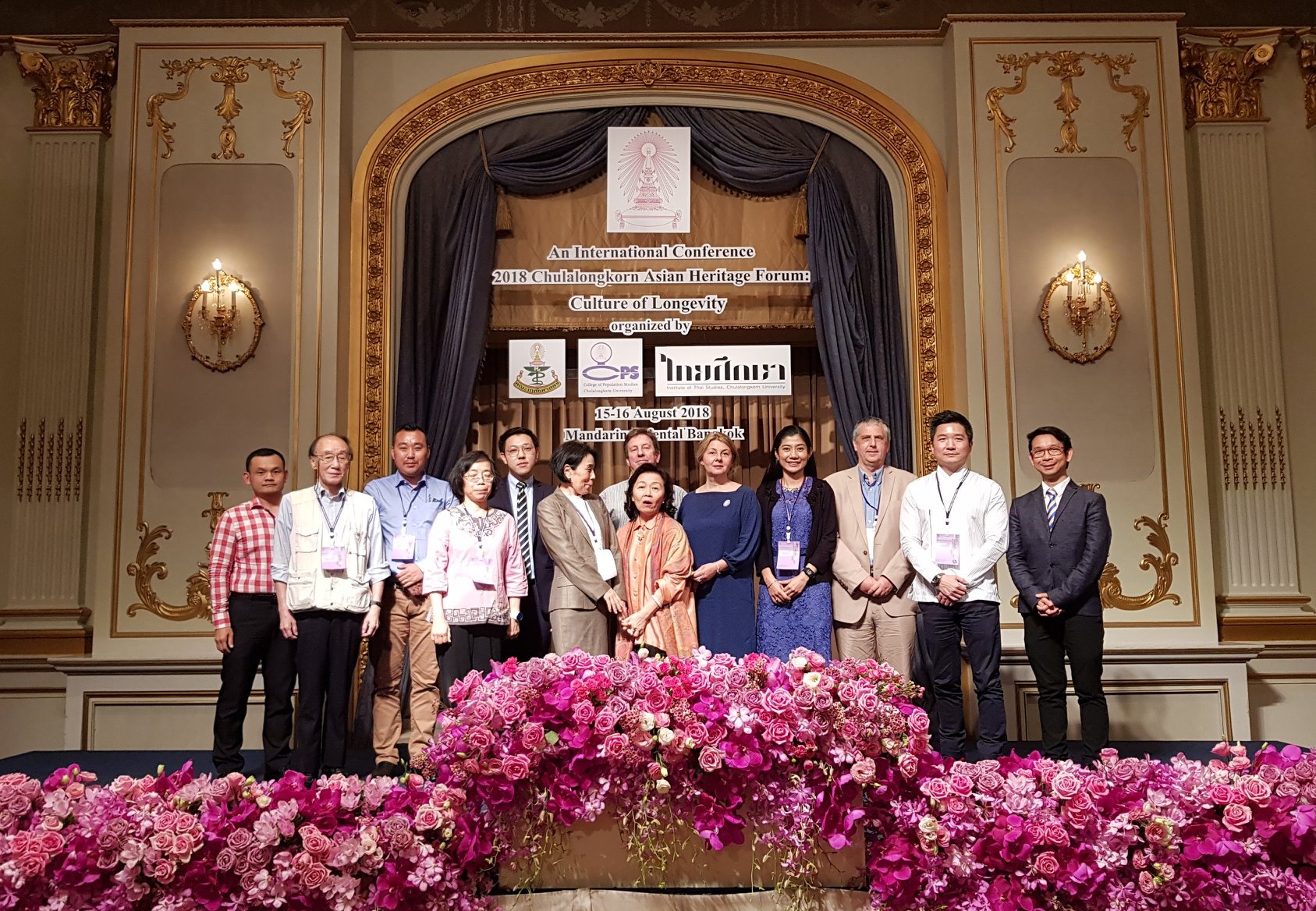 Thai Studies CU
Thai Studies CU[PHOTO ALBUM] 2018 Chulalongkorn Asian Heritage Forum : Culture of Longevity
Institute of Thai Studies, Faculty of Pharmaceutical Sciences and College of Population Studies, Chulalongkorn University organized the international conference, 2018 Chulalongkorn Asian Heritage Forum: Culture of Longevity on August 15-16, 2018 at the Mandarin Oriental Hotel, Bangkok.
The organizing committee would like to humbly express our deepest gratitude to HRH Princess Maha Chakri Sirindhorn for her gracious acceptance to preside over the opening ceremony.
Sincere appreciation is extended to all the scholars who have graciously accepted to share their wisdom in this venue. Their contribution is a genuine reflection of the success of this auspicious conference.
